听力理解(整理)
图片预览


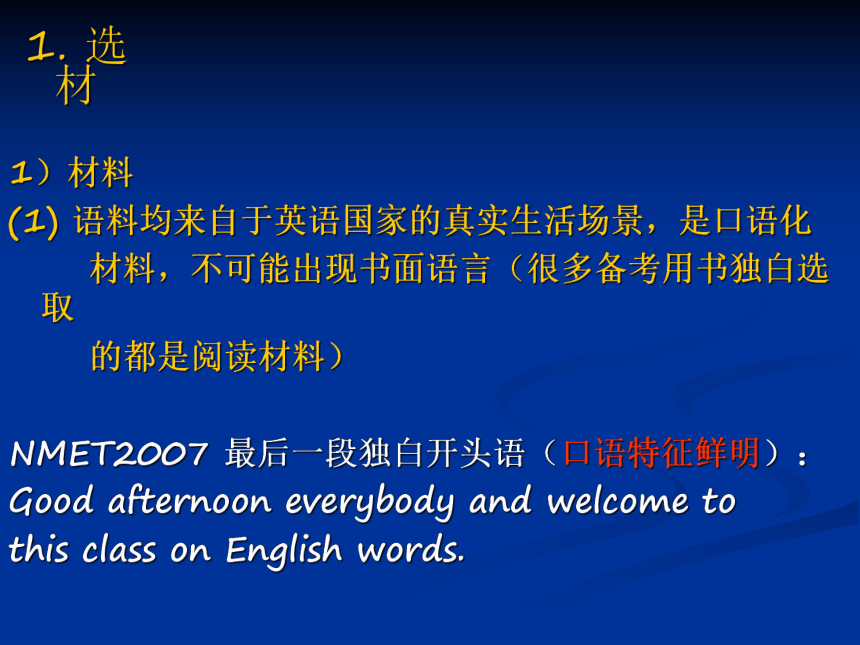
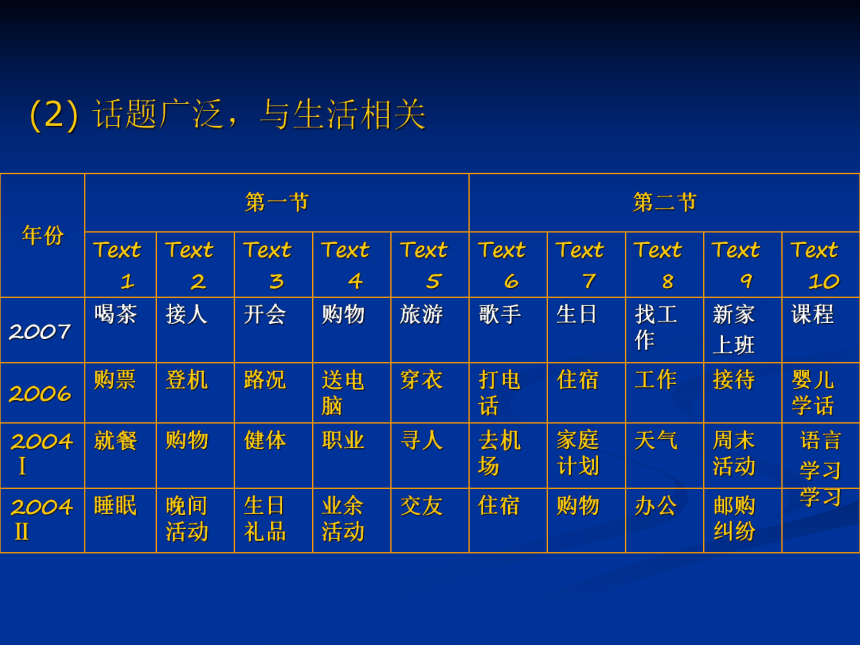
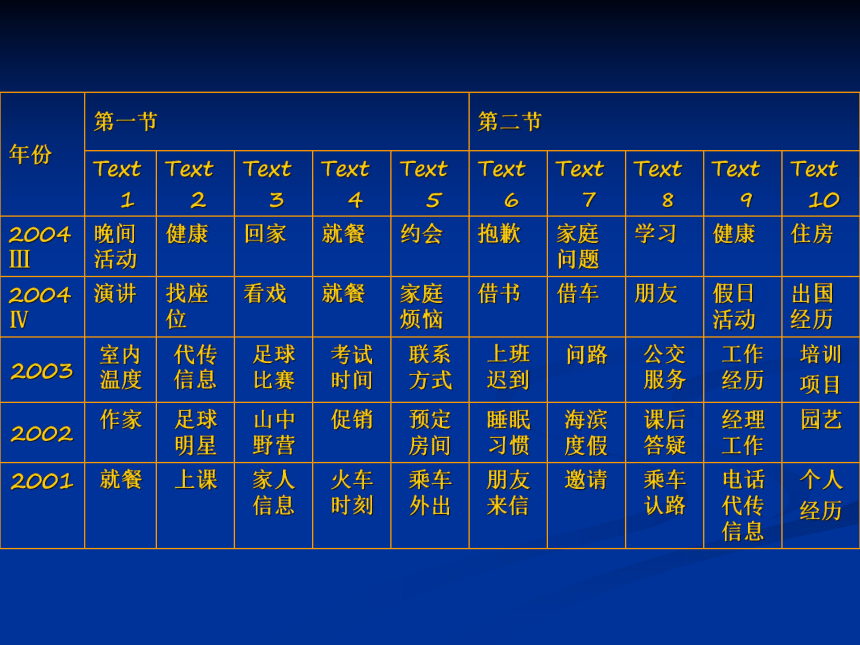
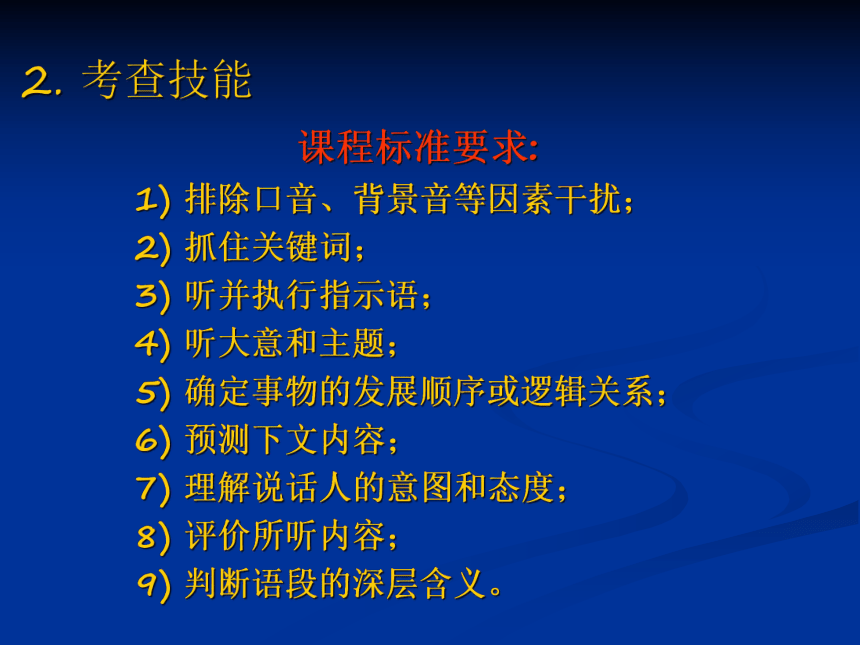
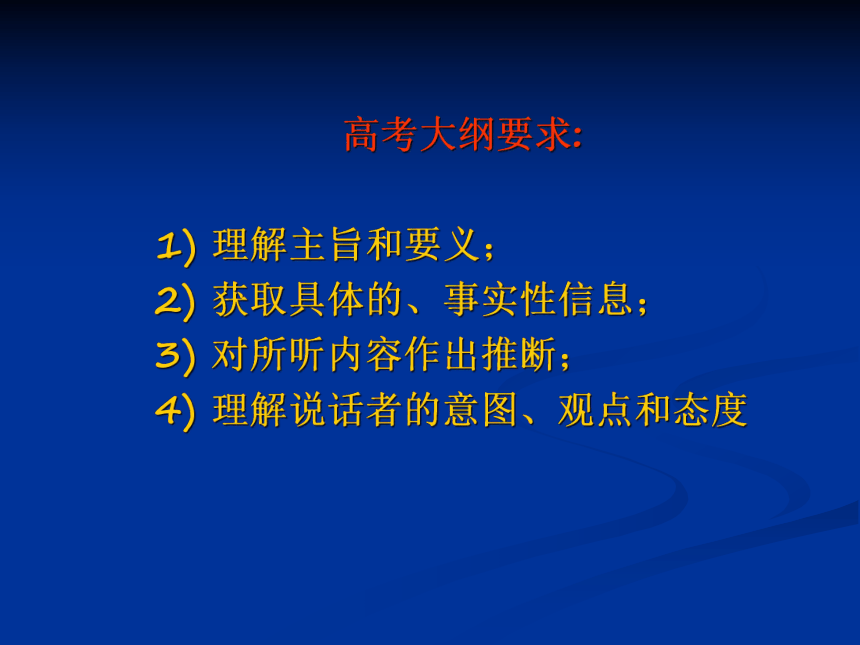
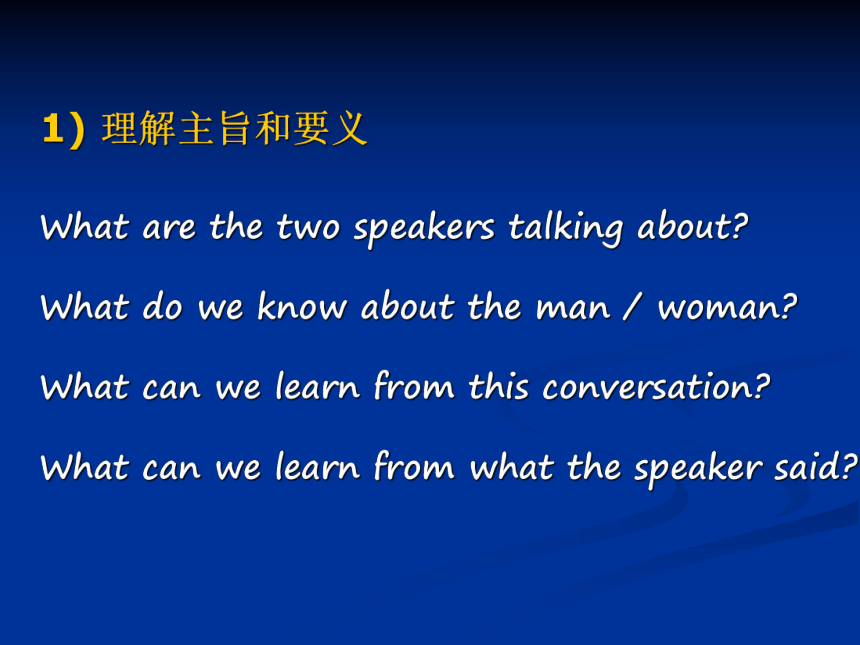
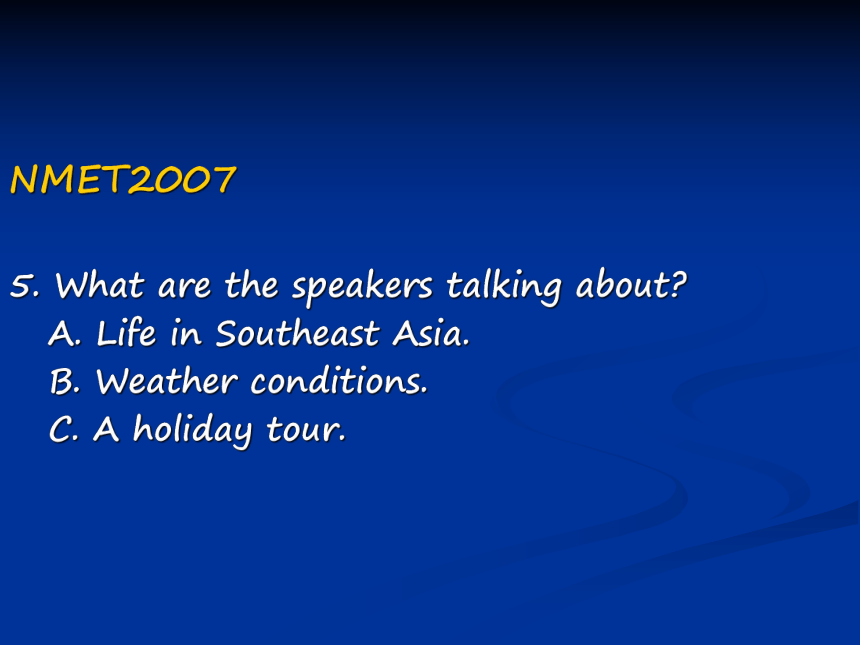
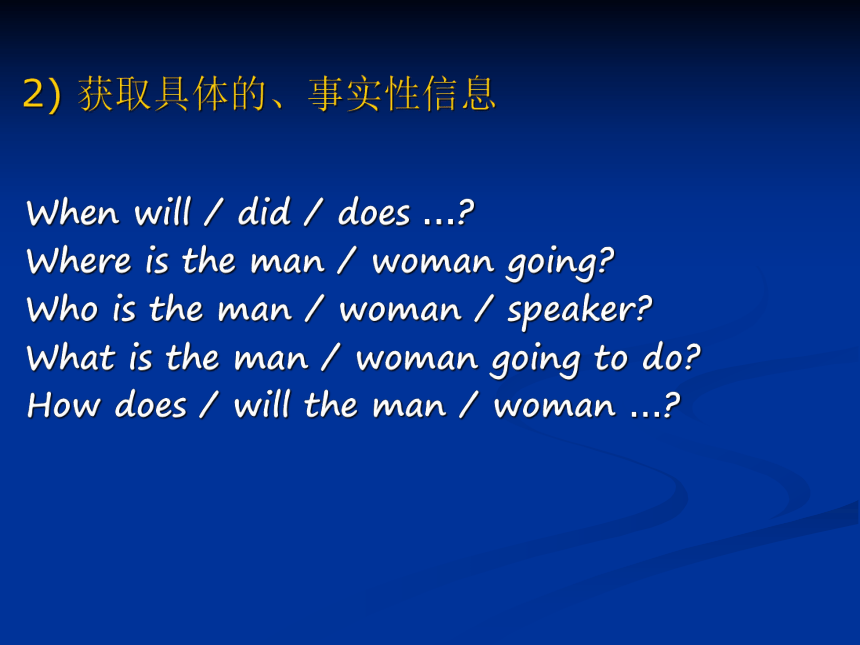
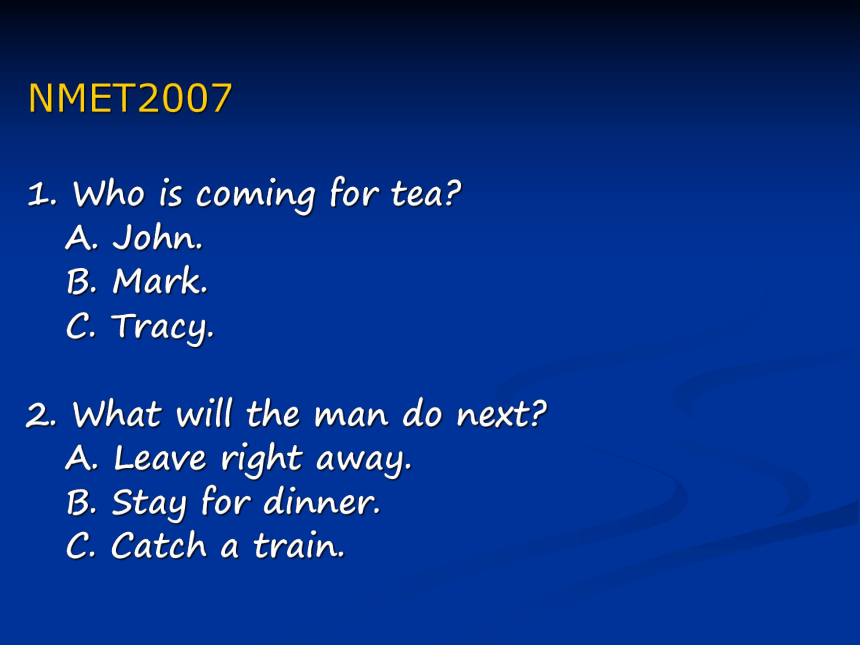
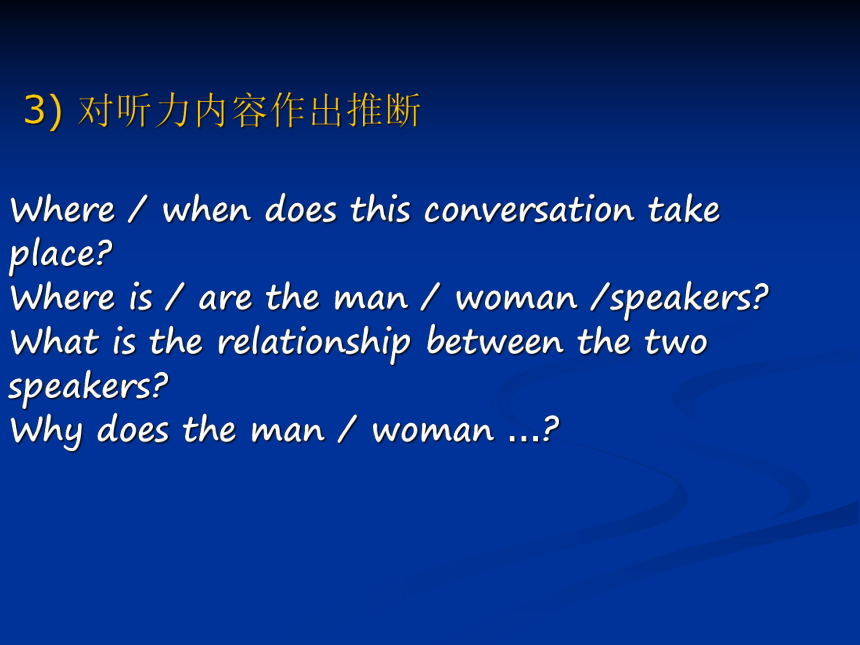
文档简介
课件60张PPT。高三英语专题复习之一 听力高考听力分析与实践软件用途:制作平台:制 作 人:制作日期:高考复习PowerPoint庐江职业与成人教育中心-宛新吾2008年5月6日 近几年高考英语全国卷听力分析1. 选材1)材料
(1) 语料均来自于英语国家的真实生活场景,是口语化
材料,不可能出现书面语言(很多备考用书独白选取
的都是阅读材料)
NMET2007 最后一段独白开头语(口语特征鲜明):
Good afternoon everybody and welcome to
this class on English words.
(2) 话题广泛,与生活相关2. 考查技能课程标准要求:
1) 排除口音、背景音等因素干扰;
2) 抓住关键词;
3) 听并执行指示语;
4) 听大意和主题;
5) 确定事物的发展顺序或逻辑关系;
6) 预测下文内容;
7) 理解说话人的意图和态度;
8) 评价所听内容;
9) 判断语段的深层含义。
高考大纲要求:
1) 理解主旨和要义;
2) 获取具体的、事实性信息;
3) 对所听内容作出推断;
4) 理解说话者的意图、观点和态度
What are the two speakers talking about?
What do we know about the man / woman?
What can we learn from this conversation?
What can we learn from what the speaker said?
1) 理解主旨和要义NMET2007
5. What are the speakers talking about?
A. Life in Southeast Asia.
B. Weather conditions.
C. A holiday tour.2) 获取具体的、事实性信息When will / did / does …?
Where is the man / woman going?
Who is the man / woman / speaker?
What is the man / woman going to do?
How does / will the man / woman …?NMET20071. Who is coming for tea?
A. John.
B. Mark.
C. Tracy.
2. What will the man do next?
A. Leave right away.
B. Stay for dinner.
C. Catch a train. 3) 对听力内容作出推断Where / when does this conversation take
place?
Where is / are the man / woman /speakers?
What is the relationship between the two
speakers?
Why does the man / woman …?
NMET200710. What is the relationship between the
speakers?
A. They are friends.
B. They are strangers to each other.
C. They are husband and wife.
17. Where can you most probably hear this
talk?
A. In a class of the English language.
B. In a class of the Greek language.
C. In a class of the French language. 4) 理解说话者的意图、观点和态度What does the man / woman think of / feel
about … ?
What does the man / woman suggest?
What do we know about the man / woman?
What was / is the purpose of …?
3. What does the man come for?
A. A lecture.
B. A meeting.
C. A party. NMET2007考点分布:3. 设题1)题干和选项较简短
题干平均词数:7.60
选项平均词数:3.82
2)各选项的语言结构基本一致 NMET2007
11. Why does the woman come to talk with the man?
A. To get a job.
B. To take a test.
C. To see the secretary.
反例:
What were the man and woman talking about?
A. Riding horses and fishing.
B. The trips they had made and the food they had
tasted.
C. Where they should go for the vacation this year.
3)干扰信息在材料中出现率高 NMET2007
1. Who is coming for tea?
A. John. B. Mark. C. Tracy.
录音稿
W: John, is Mark coming for tea tomorrow?
M: Yes. I told you yesterday, Tracy.
W: Oh, did you? Sorry, I must have
forgotten.
4)选项排列有规则 选项长度接近
短→中→长: 短→长→短:
A. … … A. … …
B. … … … B. … … …
C. … … … … C. … …
长→中→短: 长→短→长:
A. … … … … A. … … …
B. … … … B. … …
C. … … C.… … … 5)邻近题的答案选项尽量避免重复 5)各选项的答案总数接近于平均值 4. 录音1)语速
2)录音人
Listening Comprehension NMET Listening Test Section One:
5 short dialogues
(You can only listen to them once)Section Two:
Always 4 long dialogues and 1 Monologue(独白)(You can listen to them twice)1. Finding the way
2. Seeing a doctor
3. Talking about the weather
4. Shopping
5. Making phone calls
6. Time and date
7. Place
8. Requests and asking for permission
9. Advice and suggestionsContents6789T2TT11. Finding the wayQ: Excuse me. Could you please tell me the way to…?
Can you tell me where … is?
How can I get to …?
Where is the (nearest ) …, please? … A: Go down / along this street (to…)
Go straight ahead till you see…
Turn L/ R (at the 1st / 2nd crossing)
It’s about …metres’ walk /drive.
You can’t / won’t miss it! …1. What do we learn from the conversation?
A. She wants to see a movie.
B. He’s asking about the way.
C. He is a stranger, too.2. What is the woman doing?
A. Asking for directions.
B. Making a suggestion.
C. Making a decision.2. Seeing a doctorQ: What’s the trouble?
What’s wrong with you?
How long have you been like this?
…A: I feel terrible / sick / bad …
There’s something wrong with …
I’ve got a fever / headache …
…1. What’s wrong with the man?
A. He’s got a headache.
B. He’s got a running nose.
C. He’s getting tired.2. How many pills should the man take in 24 hours?
A. 12. B. 16. C. 18.3. Talking about the weatherQ: A lovely day, isn’t it?
What’s the weather like today?
How is the weather in …
Is it always as hot / cold … as this?
What does the weather forecast say? …A: It looks like / as if it’s going to rain… It’s getting cold / warm …
…1. What’s the woman going to do?
A. Join her friend.
B. Stay inside.
C. Feel warm.2. What’s being discussed?
A. A bad cold.
B. The weather.
C. The sun.4. ShoppingQ: What can I do for you?
May / Can I help you?
What color / size / kind do you want?
How many / much do you want? …A: I’d like / I want…
How much is it ? / How much, please?
That’s too expensive, I’m afraid.
Do you have any other kind / size / color?
…1. What does the man want?
A. A pair of brown shoes in size 6.
B. A pair of black shoes in size 6.
C. A pair of brown shoes in size 9.
5. Making phone callsQ: Hello! Is …in / there ?
May I / Could I speak to …?
Is that …speaking?
Can I leave a message? …A: Yes, this is … speaking.
Hold on (a second), please!
Sorry, he isn’t here right now.
May I know / ask who’s calling?
…1. What’s Mary probably doing now?
A. Cooking.
B. Shopping.
C. Calling.2. What do we get from the dialogue?
A. They’re working on a maths problem.
B. The woman is making a phone call.
C. They’re counting numbers. Listening Test 1Listen only once to the following 5 short dialogues.
One for a question.1.What does the woman mean?
A. The winter has just begun.
B. Once it starts, it’ll snow a lot.
C. It has been snowing for some time2. What does the doctor mean?
A. The man’s temperature is very high.
B.The man has got a high temperature,but not serious.
C. The man feels bad.3. Where did this conversation take place?
A. In a hotel.
B. In a guest room.
C. On a telephone. 4. Why did the customer return the dress?
A. Because she didn’t like its color.
B. Because it was too small.
C. Because it was too expensive.5. Which man can she ask for help?
A. A postman.
B. A policeman.
C. A firefighter.6. Time and dateQ: What day is it today?
What’s the date today?
Excuse me. What time is it by your watch? / What’s the time, please?1. What’s the date today?
A. August 8th.
B. August 7th.
C. August 9th.C7. Place1. Where did this conversation probably take place?
A. In a hotel.
B. In a library.
C. In a lab.C2. Where did this conversation most probably take place?
A. In a railroad station.
B. In a restaurant.
C. In a hotel room.
3. Where did the conversation most probably take place?
A. In a plane.
B. In a coffee shop.
C. In a restaurant.8. Requests and asking for permissionQ: Can / Will / Could / Would you (please) do…
May / Can / Could I do …
I wonder if I can / could do …
Do you mind if I do … / Would you mind if I did … ?A: Yes. / Sure. / Certainly./ Of course.
Go ahead, please.
That’s OK / all right. C1. What does the man want?
A. Salt.
B. Sugar.
C. Salad.2. Where is Mr. Green’s room?
A. The next door.
B. Two doors away.
C. On the next floor.9. Advice and suggestionsAdvice: You’d better (not) do …
You should / ought to do …
I suggest that sb. should do …
You don’t have to do …Suggestions: Shall we do …?
Let’s do …
What / How about …?
Why not do … ?
Why don’t you do …?
C1. What does the woman suggest he do?
A. Call a friend.
B. Work on his car.
C. Take a taxi.2. What does Ellen suggest?
A. The shopping must be done first.
B. The concert should be good.
C. She will take the things to be bought home. Listening Test 2CListen only once to the following 5 short dialogues.
One for a question.1.Where does the conversation probably take place?
A. In a clothing store.
B. At the woman’s home.
C. In the sitting room.2. What can we learn from the woman’s words?
A. The man is too tired to go to the movies.
B. The woman wants to go to the movies.
C. The woman does not want to go to the movies.3.Can the man lend the woman the hammer?
A. Yes.
B. No.
C. Hard to say. 4.Where did the conversation probably take place?
A. In a restaurant.
B. In a store.
C. In a post office.T25. What do we learn from the conversation?
A. The train may arrive at 9:15.
B. The woman isn’t sure when the train will arrive.
C. The train will not arrive.T2 Listening
TestCR1.Where are the two speakers? A. In a department store.
B. In a clothes factory.
C. On a playground.2. What time does the train leave? A. At 6:15.
B. At 6:25.
C. At 6:50.T3.What are the two speakers doing? A. Enjoying meeting each other.
B. Saying good-bye to each other.
C. Planning to see each other again.T4. What’s the man doing? A. He’s working in a hotel.
B. He’s visiting a young couple.
C.He’s travelling around.
T5. When should Susan go to meet Professor Brown? A. At 10:00.
B. At 10:30.
C. At 11:00.T1. Finding the way
2. Seeing a doctor
3. Talking about the weather
4. Shopping
5. Making phone calls
6. Time and date
7. Place
8. Requests and asking for permission
9. Advice and suggestionsRevisionT Thank you!
(1) 语料均来自于英语国家的真实生活场景,是口语化
材料,不可能出现书面语言(很多备考用书独白选取
的都是阅读材料)
NMET2007 最后一段独白开头语(口语特征鲜明):
Good afternoon everybody and welcome to
this class on English words.
(2) 话题广泛,与生活相关2. 考查技能课程标准要求:
1) 排除口音、背景音等因素干扰;
2) 抓住关键词;
3) 听并执行指示语;
4) 听大意和主题;
5) 确定事物的发展顺序或逻辑关系;
6) 预测下文内容;
7) 理解说话人的意图和态度;
8) 评价所听内容;
9) 判断语段的深层含义。
高考大纲要求:
1) 理解主旨和要义;
2) 获取具体的、事实性信息;
3) 对所听内容作出推断;
4) 理解说话者的意图、观点和态度
What are the two speakers talking about?
What do we know about the man / woman?
What can we learn from this conversation?
What can we learn from what the speaker said?
1) 理解主旨和要义NMET2007
5. What are the speakers talking about?
A. Life in Southeast Asia.
B. Weather conditions.
C. A holiday tour.2) 获取具体的、事实性信息When will / did / does …?
Where is the man / woman going?
Who is the man / woman / speaker?
What is the man / woman going to do?
How does / will the man / woman …?NMET20071. Who is coming for tea?
A. John.
B. Mark.
C. Tracy.
2. What will the man do next?
A. Leave right away.
B. Stay for dinner.
C. Catch a train. 3) 对听力内容作出推断Where / when does this conversation take
place?
Where is / are the man / woman /speakers?
What is the relationship between the two
speakers?
Why does the man / woman …?
NMET200710. What is the relationship between the
speakers?
A. They are friends.
B. They are strangers to each other.
C. They are husband and wife.
17. Where can you most probably hear this
talk?
A. In a class of the English language.
B. In a class of the Greek language.
C. In a class of the French language. 4) 理解说话者的意图、观点和态度What does the man / woman think of / feel
about … ?
What does the man / woman suggest?
What do we know about the man / woman?
What was / is the purpose of …?
3. What does the man come for?
A. A lecture.
B. A meeting.
C. A party. NMET2007考点分布:3. 设题1)题干和选项较简短
题干平均词数:7.60
选项平均词数:3.82
2)各选项的语言结构基本一致 NMET2007
11. Why does the woman come to talk with the man?
A. To get a job.
B. To take a test.
C. To see the secretary.
反例:
What were the man and woman talking about?
A. Riding horses and fishing.
B. The trips they had made and the food they had
tasted.
C. Where they should go for the vacation this year.
3)干扰信息在材料中出现率高 NMET2007
1. Who is coming for tea?
A. John. B. Mark. C. Tracy.
录音稿
W: John, is Mark coming for tea tomorrow?
M: Yes. I told you yesterday, Tracy.
W: Oh, did you? Sorry, I must have
forgotten.
4)选项排列有规则 选项长度接近
短→中→长: 短→长→短:
A. … … A. … …
B. … … … B. … … …
C. … … … … C. … …
长→中→短: 长→短→长:
A. … … … … A. … … …
B. … … … B. … …
C. … … C.… … … 5)邻近题的答案选项尽量避免重复 5)各选项的答案总数接近于平均值 4. 录音1)语速
2)录音人
Listening Comprehension NMET Listening Test Section One:
5 short dialogues
(You can only listen to them once)Section Two:
Always 4 long dialogues and 1 Monologue(独白)(You can listen to them twice)1. Finding the way
2. Seeing a doctor
3. Talking about the weather
4. Shopping
5. Making phone calls
6. Time and date
7. Place
8. Requests and asking for permission
9. Advice and suggestionsContents6789T2TT11. Finding the wayQ: Excuse me. Could you please tell me the way to…?
Can you tell me where … is?
How can I get to …?
Where is the (nearest ) …, please? … A: Go down / along this street (to…)
Go straight ahead till you see…
Turn L/ R (at the 1st / 2nd crossing)
It’s about …metres’ walk /drive.
You can’t / won’t miss it! …1. What do we learn from the conversation?
A. She wants to see a movie.
B. He’s asking about the way.
C. He is a stranger, too.2. What is the woman doing?
A. Asking for directions.
B. Making a suggestion.
C. Making a decision.2. Seeing a doctorQ: What’s the trouble?
What’s wrong with you?
How long have you been like this?
…A: I feel terrible / sick / bad …
There’s something wrong with …
I’ve got a fever / headache …
…1. What’s wrong with the man?
A. He’s got a headache.
B. He’s got a running nose.
C. He’s getting tired.2. How many pills should the man take in 24 hours?
A. 12. B. 16. C. 18.3. Talking about the weatherQ: A lovely day, isn’t it?
What’s the weather like today?
How is the weather in …
Is it always as hot / cold … as this?
What does the weather forecast say? …A: It looks like / as if it’s going to rain… It’s getting cold / warm …
…1. What’s the woman going to do?
A. Join her friend.
B. Stay inside.
C. Feel warm.2. What’s being discussed?
A. A bad cold.
B. The weather.
C. The sun.4. ShoppingQ: What can I do for you?
May / Can I help you?
What color / size / kind do you want?
How many / much do you want? …A: I’d like / I want…
How much is it ? / How much, please?
That’s too expensive, I’m afraid.
Do you have any other kind / size / color?
…1. What does the man want?
A. A pair of brown shoes in size 6.
B. A pair of black shoes in size 6.
C. A pair of brown shoes in size 9.
5. Making phone callsQ: Hello! Is …in / there ?
May I / Could I speak to …?
Is that …speaking?
Can I leave a message? …A: Yes, this is … speaking.
Hold on (a second), please!
Sorry, he isn’t here right now.
May I know / ask who’s calling?
…1. What’s Mary probably doing now?
A. Cooking.
B. Shopping.
C. Calling.2. What do we get from the dialogue?
A. They’re working on a maths problem.
B. The woman is making a phone call.
C. They’re counting numbers. Listening Test 1Listen only once to the following 5 short dialogues.
One for a question.1.What does the woman mean?
A. The winter has just begun.
B. Once it starts, it’ll snow a lot.
C. It has been snowing for some time2. What does the doctor mean?
A. The man’s temperature is very high.
B.The man has got a high temperature,but not serious.
C. The man feels bad.3. Where did this conversation take place?
A. In a hotel.
B. In a guest room.
C. On a telephone. 4. Why did the customer return the dress?
A. Because she didn’t like its color.
B. Because it was too small.
C. Because it was too expensive.5. Which man can she ask for help?
A. A postman.
B. A policeman.
C. A firefighter.6. Time and dateQ: What day is it today?
What’s the date today?
Excuse me. What time is it by your watch? / What’s the time, please?1. What’s the date today?
A. August 8th.
B. August 7th.
C. August 9th.C7. Place1. Where did this conversation probably take place?
A. In a hotel.
B. In a library.
C. In a lab.C2. Where did this conversation most probably take place?
A. In a railroad station.
B. In a restaurant.
C. In a hotel room.
3. Where did the conversation most probably take place?
A. In a plane.
B. In a coffee shop.
C. In a restaurant.8. Requests and asking for permissionQ: Can / Will / Could / Would you (please) do…
May / Can / Could I do …
I wonder if I can / could do …
Do you mind if I do … / Would you mind if I did … ?A: Yes. / Sure. / Certainly./ Of course.
Go ahead, please.
That’s OK / all right. C1. What does the man want?
A. Salt.
B. Sugar.
C. Salad.2. Where is Mr. Green’s room?
A. The next door.
B. Two doors away.
C. On the next floor.9. Advice and suggestionsAdvice: You’d better (not) do …
You should / ought to do …
I suggest that sb. should do …
You don’t have to do …Suggestions: Shall we do …?
Let’s do …
What / How about …?
Why not do … ?
Why don’t you do …?
C1. What does the woman suggest he do?
A. Call a friend.
B. Work on his car.
C. Take a taxi.2. What does Ellen suggest?
A. The shopping must be done first.
B. The concert should be good.
C. She will take the things to be bought home. Listening Test 2CListen only once to the following 5 short dialogues.
One for a question.1.Where does the conversation probably take place?
A. In a clothing store.
B. At the woman’s home.
C. In the sitting room.2. What can we learn from the woman’s words?
A. The man is too tired to go to the movies.
B. The woman wants to go to the movies.
C. The woman does not want to go to the movies.3.Can the man lend the woman the hammer?
A. Yes.
B. No.
C. Hard to say. 4.Where did the conversation probably take place?
A. In a restaurant.
B. In a store.
C. In a post office.T25. What do we learn from the conversation?
A. The train may arrive at 9:15.
B. The woman isn’t sure when the train will arrive.
C. The train will not arrive.T2 Listening
TestCR1.Where are the two speakers? A. In a department store.
B. In a clothes factory.
C. On a playground.2. What time does the train leave? A. At 6:15.
B. At 6:25.
C. At 6:50.T3.What are the two speakers doing? A. Enjoying meeting each other.
B. Saying good-bye to each other.
C. Planning to see each other again.T4. What’s the man doing? A. He’s working in a hotel.
B. He’s visiting a young couple.
C.He’s travelling around.
T5. When should Susan go to meet Professor Brown? A. At 10:00.
B. At 10:30.
C. At 11:00.T1. Finding the way
2. Seeing a doctor
3. Talking about the weather
4. Shopping
5. Making phone calls
6. Time and date
7. Place
8. Requests and asking for permission
9. Advice and suggestionsRevisionT Thank you!
